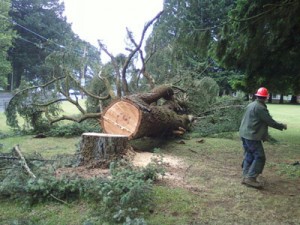The only piece of wood remaining from the giant Douglas firs that once line the entryway to St. Boniface Catholic Church lies in Henry Strobel’s barn.
“We cut a slice of a tree to hang on the wall of our museum,” said Strobel, a historian for the Sublimity church.
Strobel said it might take two or three years to dry out the wood before it can be hung.
To help retard the splitting of the 44-inch diameter and 6.5-inch thick piece of wood, he has coated both sides of the “heavy” remnant with melted paraffin.
“I see it as being hung on a wall with little flags or stick pins indicating notable events in the church placed on appropriate tree rings,” Strobel said of the future museum piece.
Another remnant of the dual avenue of aging trees lies in the flower bed directly north of the church, a testament to the rot that necessitated the felling of the tall giants in June.
The trees were planted by parishioner Ray Heuberger’s grandfather, John, after the church was built in 1889.
“Based on ring count of the stumps after the trees were removed, the trees must have been planted shortly after the church was built 123 years ago,” said Ron Etzel, a member of the Cemetery Committee. “Probably about 80-90 years ago, the 18 trees had the tops cut off and were cultured to look like identical gumdrops, with horizontal top and bottom and conical sides.”
According to Etzel, the parishioners – including Joe Spenner and Ed Hassler – manicured the trees until age forced them to allow the trees to grow naturally. Out of the tops of the then 20-foot tall trees stumps grew multiple new shoots that Etzel said eventually became 55-foot tall trees.
“So we now had as many as five or six trees growing out of each of the original trees,” he said. “Some years ago, two of the 18 were removed, leaving 16 until now.
“At the base of each of the new trees growing out of the 20-foot stumps, there became a pocket for water to settle and collect,” he added. “Over years of accumulation, the trees developed rot and decay in these areas.”
Added to the issue of water damage was the weight bearing of the new “trees” on top of the stump, he said.
“Many of the trees had grown outward and upward from the original tree, creating a tremendous weighted limb that became unstable with the rot and decay that had developed,” Etzel said. “Over time there were many occurrences of large limbs falling to the ground.”
After careful consideration and many discussions that commenced sometime in the 1980s, professional arborists were called in to evaluate the trees. Based on their reports, which had been submitted to the Archdiocese of Portland, the decision to remove the trees was made, on the basis of safety and insurance liability, Etzel said.
“The felling started on June 22 and continued all the next day,” he said. “The final cleanup occurred on June 25.”
 Ziglinski Cutting of Lyons felled the trees, with the bulk of the chainsaws and operators coming from Lulay Timber of Scio, most of whom are parishioners, Etzel said.
Ziglinski Cutting of Lyons felled the trees, with the bulk of the chainsaws and operators coming from Lulay Timber of Scio, most of whom are parishioners, Etzel said.
In the St. Boniface Archives Record, it was recorded that several local volunteers helped to rake the ground, including Tim Stuckart and his children, Eli and Peyton, Terry Hendricks and George Susbauer.
Jim Liesch took photos of the progress of the trees falling, which can be seen at his website here. Betty Young also took video and still photos of the historic event, and Strobel added a couple of short videos to his Illustrated History of Sublimity at his website here. Others involved included: Andy Heuberger, Steve and Ron Ziglinksi, David Fery, David Schumacher, Vangie Ripp and Larry Etzel.
“The loading and hauling of the logs was done by Larry Riesterer on his truck and a Freres Lumber Co. truck,” he added. “The debris was hauled also be Freres Lumber. The logs went to Wilson’s chip mill in Lyons as none of the trees were in good enough shape to use for lumber, and the debris went to Freres Lumber’s co-generation facility to be chipped and burned to generate electricity for their mill.”
Andrew Siegmund Excavating and Construction provided a large excavator with a log grapple to use in processing the logs, Etzel said.
“Eventually we hired R&R Tree Service from Salem to grind the stumps,” he added. “Finally, Tony Hendricks of Sublimity came in with his excavator and removed the roots that the stump grinder had missed. The only costs incurred were for the stump grinding, and we were given a very good price for that part of the project.”
During the project, care was taken to protect the 200-foot long concrete sidewalk that ran between the two rows of trees between the church and Main Street, Etzel said.
“It was poured in 1916, and sustained only minor damage,” he added.
The reaction to losing the trees has been mixed, but the vast majority of comments refer to how nice the church and bell tower look now, Etzel said. “Terry Hendricks, the groundkeeper for the parish, didn’t waste any time in getting the very dirty siding on the bell tower power washed,” Etzel said. “Now both buildings stand out like they did over a century ago.”
Fill dirt will be brought in to level the ground where the stumps were removed, and several years will pass before new trees will be planted, he added.
“A plot map has been developed and filed away for future use,” he said. “It gives detailed information of where the stumps were located. This way we will know where not to plant the new trees.”
Change is usually not easy to accept, and this project has been no exception, Etzel said.
“After 120 years of gracing St. Boniface Catholic Church’s landscape, the decision to carry out this project came with much emotion and anxiety,” he said. “Even thought the trees had to come down, the correct decision was made, and now we move forward.”
As for the “cookie” saved for posterity, Etzel said, when ready, “it will be displayed with the rest of the historical items that the St. Boniface Archives Committee cherishes, for all to see.”



